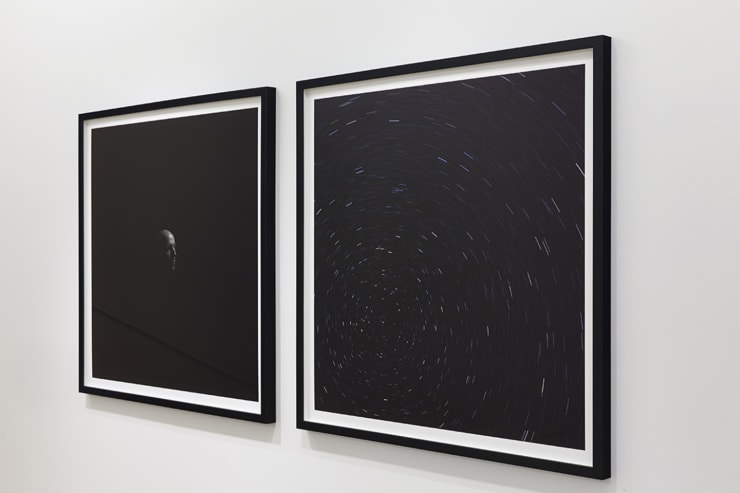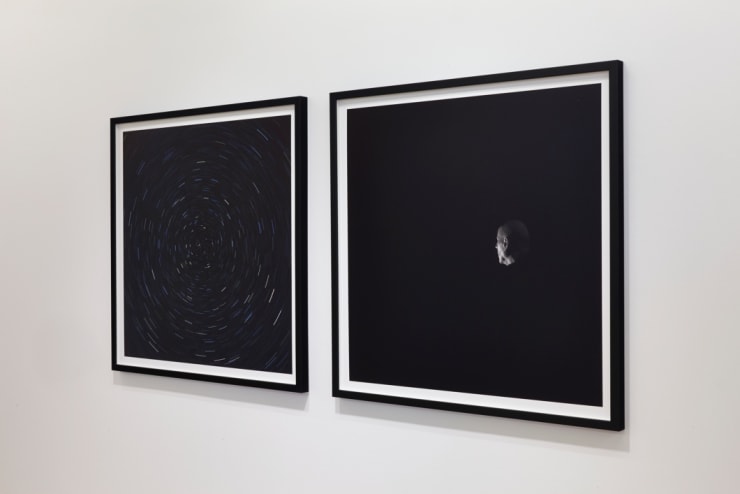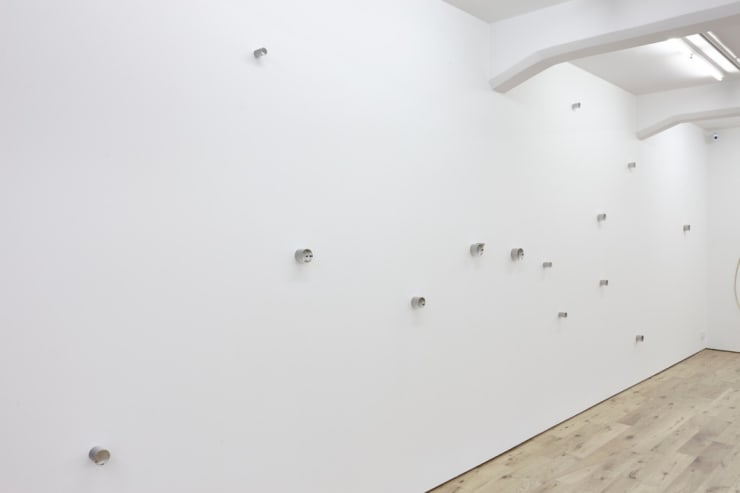1. Um hvað?
Það má líta á verk Kristins sem ólík tilbrigði við sama viðfangsefnið; Hvernig staðsetjum við okkur í umhverfinu, náum áttum í náttúrunni, pössum inn í þá heimsmynd sem við tilheyrum? Sem má draga saman enn frekar með spurningunni; Hvar erum við stödd? Að einhverju marki tilheyra verk Kristins hinu sígilda viðfangsefni skúlptúrlistar frá upphafi vega – tilveru mannsins í heiminum – þrátt fyrir að mannsmyndin sé hvergi sýnileg. Skúlptúr er staðgengill fyrir mannlega návist, nokkurs konar framlenging á eða fulltrúi fyrir líkama listamannsins. Þess vegna er það ekki líkamsformið sem er aðalatriðið heldur hvernig verkið ber sig að og kemur sér fyrir á þeim stað þar sem við mætum því. Verkið getur gert það á óendanlega margbreytilegan hátt. Verk Kristins gera það með því að spyrja spurninga – þau byrja sem upphrópunarmerki sem leiðir til spurningamerkis. Hér! Hvaðan? Hvert?
2. Hvernig?
Kristinn fæst ekki eingöngu við skúlptúr eða höggmyndalist á góðri íslensku, enda skapar hann verk af ýmsu tagi eins og sýningin ber með sér. Aftur á móti gegna þau verk sem Kristinn hefur skapað fyrir almannarými, utan sýningarsalarins á þeim stöðum sem almenningur hefur frjálst aðgengi, sérstöku hlutverki sem gefur tilefni til að líta á hann sem skúlptúrlistamann. Það er ekkert einfalt við skúlptúr lengur, eða hvað almannarými felur í sér, eða hvaða hlutverki skúlptúr (eða list almennt) getur gegnt í því. Af þessu leiðir að í verkum Kristins renna inntak og form saman í eitt, að því leyti að spurningin um stöðu mannsins í umhverfi sínu verður óaðskiljanleg frá þeirri spurningu hvaða hlutverki skúlptúr getur gegnt í almannarými.
Á ferli sem spannar um aldarfjórðung má greina hvernig Kristinn notar ólíkar nálganir til að fást við þetta tvíhliða samband. Sum verkin skoða hugmyndina um stað á nánast vísindalegan hátt, og sækja efnivið í jarðfræði, mælingar á skjálftavirkni og landreki, eða í stjörnufræði, þar sem hann skoðar það hlutverk sem himnafestingin, sólargangurinn, stjörnunar og sporbrautir þeirra og pólstjarnan sérstaklega, hafa gegnt sem náttúruleg kennileiti. Önnur nálgast viðfangsefnið frá fyrirbærafræðilegum vinkli, með því að skapa aðstæður sem lýsa því hvernig við upplifum staðsetningu okkar í umhverfinu og náum áttum, hvernig við snúum og hvert leiðir okkar liggja. Norðrið getur birst okkur hvort tveggja í senn sem vísindalegt hugtak og sem persónuleg upplifun eða jafnvel hugarástand. Og það fer ekki endilega saman hvernig norðrið er upplifað og hvernig það er notað í mælingum. Áttavitinn er eitt af þeim kerfum og verkfærum sem eru notuð til að staðsetja og leiðbeina ferðalöngum og sjófarendum þar sem allir möguleikar raðast saman á skipulegan hátt. En áttaviti getur líka verið huglægt tilfinning fyrir umhverfinu sem mótast hefur af reynslunni, hefðum og sögulegum aðstæðum. Í því sambandi hefur Kristinn skoðað talsmáta bænda, orðfæri sjómanna, nafngiftir og örnefni um áttir og mátað það við þau tæki og kerfi sem eru notuð í siglingafræði. Þannig myndast óvæntir skurðpunktar í verkum Kristins milli vísindalegs hugsunarháttar og skáldlegs ímyndunarafls. Á slíkum punktum kemur í ljós hversu margslungna þýðingu staðir og áttir hafa í lífi okkar.
3. Hvað nú?
Það er hlutverk listamannsins að leiða okkur fyrir sjónir að við erum alltaf stödd á ákveðnum Vendipunkti, þar sem hið einstæða endurtekur sig í sífellu.
//
1. About what?
Hrafnsson‘s work can be seen as variations on the same theme; How we locate ourselves in the environment, find our bearing in nature, fit in to the world-view that we belong to. Which can be further reduced to the question; Where are we now? To a certain degree Hrafnsson‘s work is dealing with the same immemorial themes of sculpture from the beginning of time – man‘s existence in the world – even though the human figure is absent. Sculpture is a proxy for human presence, a progression from and substitution for the artist‘s body. That is why it is not the human figure that is paramount but the way the work presents itself and situates itself in the very place where we encounter it. There is no end to the possible ways it can do that. Hrafnsson‘s work does it by posing questions – they start with an exclamation mark that leads to a question mark; Here! Where from? Where to?
2. How?
As an artist Hrafnsson is not exclusively preoccupied with sculpture, since his work spans a range of media, as exemplified in this exhibition. However the work he has created for public spaces, outside the gallery walls in places accessible to the general public, define him as an artist more than anything else. There is nothing simple about sculpture anymore, or about public space, for that matter, or the significance of sculpture (and art in general) within public space. Consequently form and substance merge in his work, since the question of how we find our place in the environment becomes one with the question of how sculpture can play a role in public space.
During a career spanning more than 25 years Hrafnsson has used different approaches to this two-sided question. Some works examine the idea of place in an almost scientific manner, and draw from geology, seismological measurements and continental drift, or from astronomy, to show how the heavens and solar movement, the stars and their trajectories, and the polar star in particular, have been used as natural landmarks. Other works take a phenomenologicalapproach, by recreating situations that bring to light how we find our place in the environment and find our bearings, in which direction we are turned and where we are heading. The north can appear to us simultaneously as a scientific notion and as a personal experience or even state of mind. And the way we experience the north and the way it is used in measurements need not coincide. The compass is one of the systems and tools used to locate and direct travellers and seafarers, where all possibilities are organised on a continuous scale. But the compass can also represent a subjective sense of place that has been forged through experience, convention and historical circumstance. Therefore Hrafnsson has collected the idioms of farmers and sailors, phrases and place names that relate to directions and matched them with the systems and tools used in navigation, in order to create interesting intersections where scientifically oriented thought and poetic imagination cross paths. Such intersections bring to light the complex significance of place and direction in our lives.
3. What now?
The artist‘s role is to make us realize that we are always arriving at a certain Turning Point, where the unique repeats itself continually.
Gunnar J. Árnason (translated by the author)



















